Telangana TSBIE TS Inter 1st Year Zoology Study Material 4th Lesson Animal Diversity-II: Phylum Chordata Textbook Questions and Answers.
TS Inter 1st Year Zoology Study Material 4th Lesson Animal Diversity-II: Phylum Chordata
Very Short Answer Type Questions
Question 1.
List out the characters shared by chordates and echinoderms.
Answer:
Chordates share deuterostomeate condition, radial and indeterminate type of cleavage and enterocoelom with the echinoderms.
Question 2.
Write four salient features of cyclostomes.
Answer:
Salient features of cyclostomes
- These are jawless aquatic forms.
- Body is scaleless, long, slender and eel-like.
- Endoskeleton is cartilaginous
- Mouth is circular and suctorial. Tongue bears horny teeth.
Question 3.
What is the importance of endostyle in lancelets and ascidians?
Answer:
In ascidians and lancelets, ventral side of the pharynx possesses an endostyle which is believed to be the fore runner of the thyroid gland of a vertebrate. It helps in nutrition.
Question 4.
Name the type of caudal fin and scales that are present in a shark and Catla, respectively.
Answer:
- Shark → Heterocercal caudal fin and placoid scales are seen.
- Catla → Homocercal caudal fin, ctenoid or cycloid scales are seen.
Question 5.
What is the importance of air bladder in fishes?
Answer:
An air bladder is present with or without connection to the gut. It is either helpful in gas exchange or in maintaining buoyancy.
Question 6.
How do you justify the statement-“heart in fishes is a branchial heart”?
Answer:
Fish heart is known as ‘branchial heart’ as it supplies blood only to the gills.
![]()
Question 7.
What are claspers? Which group of fishes possesses them?
Answer:
In the group chondrichthyes males possess claspers on pelvic fins to facilitate internal fertilization, (example : shark).
Question 8.
How does the heart of an amphibian differ from that of a reptile? [March 2015 – T.S.]
Answer:
- Heart in amphibians is 3 chambered with sinus venosus and conus arteriosus.
- Heart in reptiles is completely four chambered except in the crocodiles. Sinus venosus is present but conus arteriosus is absent.
Question 9.
Name the structures that appeared for the first time in amphibians, in the course of evolution.
Answer:
Tympanum, Lacrimal and Harderian glands (associated with eye) appeared for the first time in the amphibians in the course of evolution.
Question 10.
How do you distinguish a male frog from a female frog? [March 2018 – A.P.]
Answer:
Male frog can be distinguished by the presence of sound amplifying vocal sacs and also a copulatory pad on the first digit of each forelimb. They are absent in female frogs.
Question 11.
What is ‘force pump’ in frog? Why is it named so?
Answer:
In frog during the pulmonary respiration, the bucco – pharyngeal cavity acts like a “force pump”. Due to the elevation of bucco – pharyngeal cavity the air forces the glottis to open and enter the lungs, where exchange of gases takes place.
Question 12.
What are corporabigemina? Mention their chief function.
Answer:
In amphibians Mid brain is represented by a pair of optic lobes called corpora bigemina. The optic lobes are associated with the sense of sight.
![]()
Question 13.
Distinguish between mesorchium and mesovarium.
Answer:
- In male frog testes are attached to kidney and dorsal body wall by a double fold of peritoneum called mesorchium.
- In female frog ovaries are attached to the kidneys and dorsal body wall by a double fold of peritoneum called mesovarium.
Question 14.
Distinguish between milt and spawn. [Mar. 2017 – A.P ; May/June 2014,]
Answer:
- Mass of eggs released by a female frog into water is called Spawn.
- Mass of sperms released by a male frog into water is called Milt.
Question 15.
What are the “Golden ages” of the first jawed vertebrates and the first amniotes?
Answer:
- Golden age of first jawed vertebrates is “DEVONIAN PERIOD” (Fishes)
- Golden age of first amniotes is MESOZOIC ERA (Reptiles)
Question 16.
Name two poisonous and non-poisonous snakes found in South India. [March 2014]
Answer:
- Two poisonous snakes found in South India are a) Naja naja (cobra), b) Bungarus (Krait)
- Two non-poisonous snakes found in South India are a) Ptyas (rat snake) b) Tropidonotus (pond snake)
Question 17.
In which features does the skin of a reptile differ from that of a frog?
Answer:
- Skin of a frog is thin, scaleless and moist.
- Skin of a reptile is rough and dry. The exoskeleton occurs in the form of horny epidermal scales, shields and claws.
Question 18.
Describe a cat and a lizard on the basis of their chief nitrogenous wastes excreted.
Answer:
- Reptiles excrete uric acid as nitrogenous waste (uricotelic).
- Cat excrete urea as nitrogenous waste (ureotelic).
Question 19.
Name the four extra embryonic membranes. [March 2020]
Answer:
The four extra embryonic membranes are a) Amnion b) Allantois c) Chorion and d) Yolk sac.
![]()
Question 20.
What are Jacobson’s organs? What is their function?
Answer:
Jacobson’s organs, the specialized olfactory structures are highly developed in lizards and snakes.
Question 21.
What are pneumatic bones? How do they help birds?
Answer:
In birds bones are hollow or air filled and referred to as pneumatic bones. They help in reducing the weight, thus help in effective flying (aerial adaptation).
Question 22.
What is ‘wish bone’? What are the skeletal components that form it?
Answer:
In birds both clavicles are fused with the interclavicle to form a ‘V’- shaped bone, called furcula or ‘wish bone’ or merry thought bone.
Question 23.
What is continuous oxygenation of the blood? How is it made possible in birds?
Answer:
In birds the compact spongy lungs are associated with air sacs. Air sacs facilitate continuous oxygenation (oxygen supplied to lungs uninterruptedly and heavily) of blood and pneumacity of bones.
Question 24.
Distinguish between the crop and the gizzard in birds.
Answer:
a) In birds oesophagus is often dilated into crop for the storage of food.
b) Stomach is usually divided into glandular proventriculus and muscular gizzard (grinding mill).
Question 25.
Distinguish between altricial and precocial hatchlings.
Answer:
- Altricial hatchlings are seen in flying birds which are incapable of moving around on its own soon after hatching.
- PrecOcial hatchlings are seen in flightless birds which are capable of moving around on its own soon.
![]()
Question 26.
In which group of animals do we find three ear ossicles on each side and what are their names from the innermost to the outermost?
Answer:
In mammals, we find three ear ossicles on each side. From innermost to outer¬most they are stapes, incus and malleus.
Question 27.
How does a mature RBC of a mammal differ from that of other vertebrates?
Answer:
Mature RBC in mammals is unique because it is circular, biconcave and enucleate.
In other vertebrates RBC are oval, biconvex and nucleated.
Question 28.
Name the characteristic type of vertebrae found in reptiles, birds and mammals.
Answer:
Characteristic vertebrae
- In Reptiles → Procoelous.
- In Birds → Heterocoelous
- In Mammals → Amphiplatyan.
Question 29.
Name the three meninges. In which group of animals do you find all of them?
Answer:
The three meninges which are brain layers are
a) Dura Mater b) Arachnoid membrane c) Piamater.
The group mammals possess all the three layers.
![]()
Question 30.
Name the vertebrate groups in which ’renal portal system’ is absent.
Answer:
Renal portal system is absent in the group Mammals.
Short Answer Type Questions
Question 1.
Give three major differences between chordstes and non-chordates and draw the sketch of a chordate’s body showing those features.
Answer:
Major differences between chordates and non-chordates:
| Chordates | Non-chordates |
| 1. Notochord is present | Notochord is absent |
| 2. Pharynx is perforated by gill slits | Gill slits are absent |
| 3. Heart is ventral | Heart is dorsal (if present). |
| 4. A post-anal tail is present. | Post-anal tail is absent |
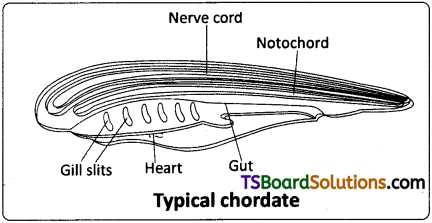
Question 2.
Name the four ‘hallmarks’ of chordates and explain the principal function of each of them. [March 2020, 18]
Answer:
The four principal chordate characters and their functions are
a) Notochord :
Flexible rod like structure placed along the mid dorsal line between gut and nerve cord. It is a supporting structure.
b) Dorsal tubular nerve cord :
A single hollow tubular and fluid filled nerve cord is situated above notochord and below dorsal body wall. It is sensory in function. In higher chordates anteriorly it becomes brain and the rest becomes the spinal cord.
c) Pharyngeal gill slits :
These are a series of lateral perforations in the wall of pharynx which are ecto-endodermal in origin. They are helpful in the exchange of respiratory gases.
d) Post-anal tail :
Chordates have a tail extending posterior to the anus. It is lost in many species during embryonic development. It provides the propelling force in the locomotion of aquatic forms and act as a balancing organ in many terrestrial animals.
Question 3.
Describe the features of a tunicate that reveals its chordate identity.
Answer:
SUBPHYLUM – UROCHORDATA OR TUNICATA : All urochordates are marine and occur from the surface water to greater depths. They are either sessile (ascidians) or pelagic (Salpa, Doliolum) and solitary (Ascidia) or colonial (Pyrosoma).
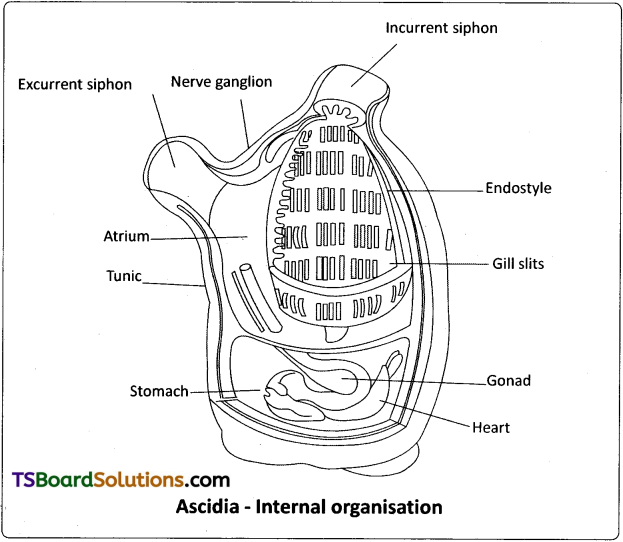
Body is un-segmented and covered by a ‘test’ or ‘tunic’ composed of cellulose1 which is uncommon in animals. Coelom is absent. However, an ectoderm – lined atrial cavity surrounds the pharynx, into which gill slits, anus and genital ducts open. Ventral side of the pharynx possesses an endostyle, (see Glossary) which is believed to be the ‘forerunner’ of the thyroid gland of a vertebrate. Atrium leads to the exterior by a dorsal or posterior atrial aperture. Digestive tract is ‘complete’.
Two to numerous gills slits are found in the pharyngeal wall. Circulatory system is of ‘open type’. There is a simple, tubular, ventral heart which alternately reverses the direction of the flow of blood. Nervous system is represented in the adult by a single dorsal ‘ganglion’. They are bisexual or hermaphrodites. Development generally includes a free-swimming tadpole larva with a tail, a dorsal hollow nerve cord, and a notochord confined to the tail, hence the name urochordata. e.g.: Ascidia, Salpa, Doliolum, Pyrosoma and Oikopleura.
Question 4.
Compare and contrast sea squirts and lancelets.
Answer:
| Sea squirts | Lancelets |
| 1) Marine and occur from the surface water to greater depths. Sessile or pelagic and solitary or colonial. | 1) Marine forms lead a burrowing mode of life in shallow sea waters. |
| 2) Body is unsegmented and covered by a test or tunic made up of cellulose. | 2) Body is fish like, translucent with median fins but without paired fins. |
| 3) Larva stage exhibits a tail, dorsal hollow nerve cord and a notochord confined to the tail, hence the name urochordata. | 3) Often described as typical chordate because they possess principal chordate. Chordates such as notochord, tubular nerve cord and pharyngeal gill slits throughout their life. |
| 4) Circulatory system is of open type. Simple, tubular, ventral heart which alternately reverses the direction of the flow of blood. Example: Ascidia (sea squirt) |
4) Circulatory system is of closed type and heart, blood corpuscles and respiratory pigment are absent. Example: Branchiostoma (lancelet) |
![]()
Question 5.
List out eight characteristics that help distinguish a fish from the other vertebrates. [March 2019]
Answer:
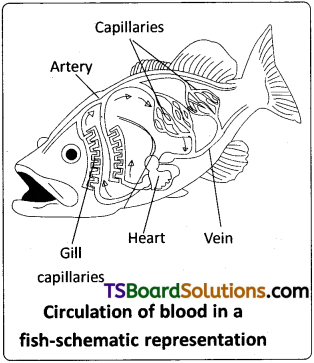
Characteristics of group PISCES.
- Fishes are completely aquatic poikilo- thermic (cold blooded ) animals.
- Body of a fish is usually streamlined and differentiated into head, trunk and tail.
- Exoskeleton consists of mesodermal scales or bony plates. A few are scaleless.
- Endoskeleton may be cartilaginous or bony. Skull is monocondylic. Vertebrae are amphicoelous (centrum is concave at both anterior and posterior faces).
- Locomotion is assisted by unpaired (median and caudal) fins along with paired (pectoral and pelvic) fins.
- Mouth is ventral or terminal. Teeth are usually acrodont, homodont and polyphyodont.
- Exchange of respiratory gases is performed by the gills.
- Heart is ‘two chambered’ and is described as ‘branchial heart’ as it supplies blood only to the gills.
- Lateral line sensory system is well developed.
Question 6.
Compare and contrast cartilaginous and bony fishes. [May 2017 – A.P.; May/June. Mar. 2014 ; March 2013]
Answer:
| Cartilaginous fishes | Bony fishes |
| 1) Caudal fin is heterocercal | 1) Caudal fin is diphycercal or homocercal. |
| 2) Scales if present placoid scales. | 2) Scales are ganoid, cycloid or ctenoid scales. |
| 3) Endoskeleton is entirely cartilage. | 3) Endoskeleton is bony. |
| 4) Mouth and nostrils are ventral. | 4) Mouth is usually terminal. |
| 5) Digestive tract opens into cloaca, if present. | 5) Digestive tract opens out by anus. |
| 6) Air bladder is absent. | 6) Air bladder is often present. |
| 7) Fertilization is internal. Mostly viviparous. eg: Scoliodon. |
7) Fertilization is external. Mostly oviparous. Eg: Catla catla |
![]()
Question 7.
Describe the structure of the heart of frog.
Answer:
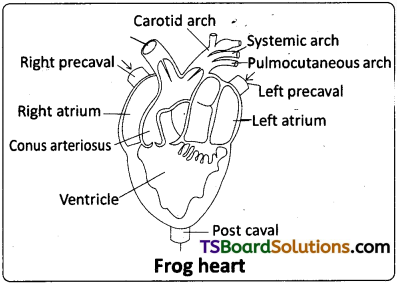
The heart is a muscular organ situated in the upper part of the body cavity. If has two separate atria and a single undivided ventricle. It is covered bye double layered membrane called pericardium. A triangular chamber called sinus venosus joins the right atrium on the dorsal side. It receives blood through three vena cavae (caval veins). The ventricle opens into the conus arteriosus on the ventral side. The conus arteriosus bifurcates into two branches and each of it divides into three aortic arches namely carotid, systemic and pulmocutaneous. Blood from the heart is distributed to all parts of the body by the branches of aortic arches. Three major veins collect blood from the different parts of the body and carry it to the sinus venosus.
Question 8.
Write eight salient features of the class Amphibia.
Answer:
- Body is divided into distinct’head’ and’trunk’. Tail may or may not be present.
- Skin is soft, scale-less (except the members of Apoda), moist and glandular.
- The body bears two pairs of equal or unequal pentadactyle limbs (caecilians are limbless).
- Skull is dicondylic as in mammals. Vertebrae are mostly procoelous (centrum is concave at its anterior face only) in the anurans, amphicoelous in the caecilians and usually opisthocoelous (centrum is concave at its posterior face) in the urodeles. Sternum appeared for the first time in the amphibians.
- Mouth is large; teeth are acrodont, homodont and polyphyodont.
- Respiratory gaseous exchange is mostly cutaneous; pulmonary and bucco pharyngeal respirations also occur. Branchial respiration is performed by larvae and some adult urodeles.
- Heart is three-chambered with sinus venosus and conus arteriosus. Three pairs of aortic arches and well-developed portal systems are present; erythrocytes are nucleate.
- Kidneys are mesonephric; ureotelic.
- Meninges are the inner piamater and outer duramater; cranial nerves are 10 pairs.
- Middle ear consists of a single ear ossicle, the columella auris which is the modified ‘hyomandibula’ of the fishes. Tympanum, lacrimal and harderian glands appeared for the first time in the amphibians.
- Sexes are separate and fertilization is mostly external. Development is mostly indirect, e.g.: Bufo (toad), Rana (frog), Hyla (tree frog), Salamandra (salamander), Ichthyophis (limbless amphibian), Rhacophorus (flying frog).
Question 9.
Describe the male reproductive system of frog with the help of a labelled diagram.
Answer:
Male Reproductive System of frog:
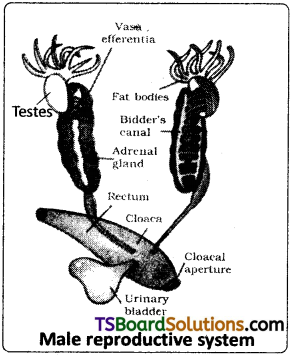
The male reproductive system consists of a pair of yellowish and ovoid testes, which are attached to the kidneys and dorsal body wall by a double fold of peritoneum called mesorchium. Each testis is composed of innumerable seminiferous tubules which are connected to form 10 to 12 narrow tubules, the vasa efferentia. They enter the kidneys and open into the Bidder’s canal which is connected to the ureter through transverse canals of the kidney. The urino-genital ducts of both the sides open into the cloaca.
Question 10.
Write short notes on organs of special senses in frog.
Answer:
Organs of special senses : Frog has sense organs such as the organs of touch, taste, smell, sight and hearing. The well-organised structures among them are eyes, internal ears and the rest are ‘cellular aggregations’ around nerve endings. The receptors of touch occur in the skin. Organs of taste are called taste buds that lie on small papillae of tongue. The organs of smell are a pair of nasal chambers.
The organs of sight are a pair of eyes located in the orbits of the skull. Eyes are protected by eyelids. The upper eyelid is immovable. The lower eyelid is folded into a transparent nictitating membrane, which can be drawn across the surface of the eye. The retina of the eye contains both rods and cones. Cones provide ‘colour vision’ and rods are helpful in ‘dimlight vision’.
Ear is useful for hearing and balance. It consists of a middle ear closed externally by a large tympanic membrane (ear drum) and a columella that transmits vibrations to the inner ear. The inner ear consists of a utriculus with three semicircular canals and a small sacculus.
![]()
Question 11.
List out the salient features of exo and endoskeleton in reptiles.
Answer:
Skin is rough and dry. The exoskeleton occurs in the form of horny epidermal scales, shields, and claws (which appeared for the first time in reptiles).
Dentition is acrodont, homodont and polyphyodont (thecodont in corcodiles as seen in the mammals). Chelonians are ‘edentate’.
Skull is monocondylic and many have temporal fossae. Each half of the lower jaw is formed by six bones. Vertebrae are mostly procoelous. The first two cervical vertebrae are specialized into atlas and axis to facilitate independent movement of the head from the rest of the body; sacral vertebrae are two in number.
Question 12.
List out the extant orders of the Class Reptilia. Give two examples for each order.
Answer:
The extant reptiles are grouped into four orders.
1. Chelonia –
Chelone (marine green turtle), Testudo (terrestrial form), Trionyx (fresh water form)
2. Rhynchocephalia –
Sphenodon (a ’living fossil’, endemic to New Zealand)
3. Crocodilia –
Crocodylus palustris (Indian crocodile or maggur), Alligator (alligator), Gavialis gangeticus (Indian gavial or gharial)
4. Squamata
a) Lizards – Hemidactylus (wall lizard), Chameleon, Draco (flying lizard)
b) Snakes
i) Poisonous snakes – Naja naja (cobra), Ophiophagushannah (King cobra), Bungarus(Krait), Daboia/Vipera russelli (chain viper).
ii) Non-poisonous snakes- Ptyas (rat snake), Tropidonotus (grass snake or pond snake)
Question 13.
What are the modifications that are observed in birds that help them in flight? [Mar. 2017 – A.P : Mar. 2015 – A.P & T.S]
Answer:
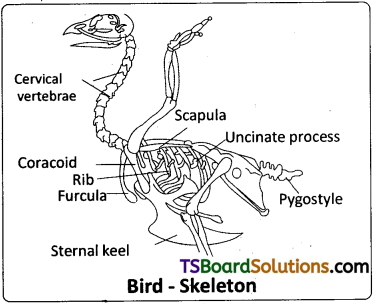
- Body is streamlined
- The fore limbs are modified into ‘wings for flight.
- Skin is dry and devoid of glands, except the oil or preen gland or uropygial gland at the base of the tail to protect tail feathers.
- Exoskeleton consists of epidermal feathers (a unique feature), with interlocking system.
- Long bones are hollow with air cavities (pneumatic). Skull is monocondylic. Vertebrae are heterocoelous. The last thoracic, lumbar, sacral and anterior few caudal vertebrae are fused to form a synsacrum. it is fused with pelvic girdle to provide support to hind limbs. A few posterior most caudal vertebrae are fused to form the pygostyle that provides support to the tail feathers. Sternum has a keel/ carina for the attachment of flight muscles (except in the ratite birds). Both the clavicles are fused with the interclavicle to form a V – shaped bone, called furcula or ‘Wish bone1 or ‘Merry thought bone’.
- All modern flying birds are provided with powerful breast muscles (flight muscles), chiefly the pectoralis major and pectoralis minor.
Question 14.
What are the features peculiar to ratite birds? Give two examples of ratite birds.
Answer:
Ratitae / Palaeognathae :
They are modern flightless running birds. They are ‘discontinuous’ in their distribution like the lung fishes and marsupials. They are characterized by the presence of reduced wings, a raft like sternum without keel and males with penis. They do not possess syrinx, clavicles and usually preen gland, e.g. Struthio camelus (African ostrich), Kiwi (National bird of N6w Zealand), Rhea (American ostrich), Dromaeus (Emu), Casuarius.
![]()
Question 15.
Mention the most important features of nervous system and sense organs in mammals.
Answer:
Mammals have a relatively large brain when compared to that of other animals in relation to body size. The four optic lobes constitute corpora quadrigemina. The two halves of cerebrum are connected by corpus callosum. The CNS is enveloped by three meninges. The middle menix called, arachnoid membrane, is present in mammals only.
Cranial nerves are twelve pairs. Eyes have movable eye lids with ‘eye lashes’. External ear has a large fleshy and cartilaginous flap called pinna. Middle ear possesses three ear ossicles. They are malleus, incus and stapes. Cochlea of the internal ear is spirally coiled and bears the ‘organ of Corti’ which is the receptor of sound.
Question 16.
Write short notes on the following features of the eutherians.
a) Dentition
b) Endoskeleton.
Answer:
a) Dentition :
Teeth are thecodont, heterodont and diphyodont. Four pairs of salivary glands are present in association with the buccal cavity (3 pairs in man).
b) Endoskeleton :
Skull is dicondylic. Each halfofthe lowerjaw consists of a ‘single’ bone, the dentary. Most mammals have seven cervical vertebrae, six in Choloepus (two toed sloth) and Trichechus (manatee) and nine in Bradypus (three-toed sloth).Sacral vertebrae are two to five. Vertebrae are of the amphiplatyan type (centrum is flat at both faces). Ribs are double – headed. Buccal cavity is separated from the upper nasal cavity by a secondary palate.
Question 17.
Give an example for each of the following, a) A viviparous fish, b) A fish possessing electric organs, c) A fish possessing poison sting, d) An organ which regulates buoyancy in the body of fish, e) An oviparous animal with milk producing glands.
Answer:
a) Viviparous fish – Scoliodon (dog fish /shark)
b) Fish possessing electric organs – Torpedo (electric ray)
c) Fish possessing poison sting – Trygon (Sting ray)
d) Organ which regulates buoyancy in the body of fish – Air bladder.
e) Oviparous animal with milk producing glands – Ornithorhynchus (Duck-billed platypus)
Question 18.
Mention two similarities between a) Aves and mammals b) A frog and a crocodile c) A lizard and a snake.
Answer:
A) Aves and mammals :
- Ribs are double headed in both gorups.
- Heart is 4 chambered.
- Kidneys are metanephric.
- Cranial nerves are twelve pairs.
B) A frog and a crocodile :
- Both are amphibians and can lead life on land and in water.
- Cloaca is present.
- Middle ear consists of a single ear ossicle, the columella auris.
C) A lizard and a snake :
- Jacobson’s organs, the specialized olfactory structures are highly developed in lizards and snakes.
- In lizards and snakes also some are oviparous and some are viviparous.
![]()
Question 19.
Name the following animals, a) A limbless amphibian b) The largest of all living animals c) An animal possessing dry and cornified skin d) ‘National Animal’ of India.
Answer:
a) A limbless amphibian : Ichthyophis
b) The largest of all living animals : Balaenoptera (Blue whale)
c) An animal possessing dry and cornified skin : Reptiles (eg : Sphenodon)
d) National animal of India : Panthera tigris (tiger)
Ornithorhynchus (Duck-billed platypus)
Question 20.
Write the generic names of the following.
a) An oviparous mammal
b) Flying fox
c) Blue whale
d) Kangaroo
Answer:
a) An oviparous mammal – Ornithorhynchus (Duck-billed platypus)
b) Flying fox – Pteropus
c) Blue whale – Balaenoptera.
d) Kangaroo – Macropus.